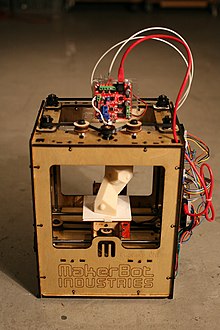User:Indigojin/Thing-O-Matic/sandbox
Thing-O-Matic[edit]
History[edit]
The Thing-O-Matic is a 3D printer developed by MakerBot Industries. Introduced in September 2010 at Maker Faire NYC,[1] the Thing-O-Matic is MakerBot's second 3D Printer kit. The Thing-O-Matic shipped with many of the common upgrades that had been built for Cupcake CNC printers previously. The stock Thing-O-Matic shipped with a heated, automated build platform, a MK5 plastruder, a redesigned z-stage, and upgraded electronics (Generation 4). Later batches of Thing-O-Matic printers shipped with a MK6 Stepstruder, a stepper motor-based extruder instead of the DC motor unit used previously as well as the parts to print using smaller 1.75 mm filament stocks.[2]. Orders placed as of September 15th, 2011 ship with a MK7 Stepstruder, specifically designed for use with 1.75mm filament only.
Specifications[edit]


Parts are fabricated using acrylonitrile butadiene styrene ABS or Polylactic acid PLA with an extrusion head with z axis mobility and a platen with x and y axis mobility. Fully assembled, the exterior dimensions are 300 x 300 x 410 mm (12″ W x 12″ D x 16″ H) with a build envelope of 96 x 108 x 115 mm. The device interfaces using USB or Secure Digital (SD) card.
The Thing-O-Matic is currently sold for $1,099 disassembled and $2,400 fully assembled as of Nov. 29, 2011. Thing-O-Matic serial numbers start at #3000 and as of March 2011 are up to approximately 3850. The current lead time is 4-5 weeks for both disassembled and fully assembled models [3] The use of an automatic build platform is unique to the Thing-O-Matic. This component allows for the user to queue items to print, printing each individually, ejecting the final part after cooldown, and then beginning on the next item. This gives the printer the capability to execute a queue of print jobs unattended. It has been determined that in some configurations base layer material does not adhere well to the plastic belt surface. It has been proposed[4] that using a titanium belt could fix this issue. Other users simply use the heated build platform and print on a layer of masking tape (specifically blue painters tape) or kapton tape.
Instructions for assembly are provided online through the Makerbot Wiki.[5] The Thing-O-Matic is open-source hardware and is licensed under the GNU GPLv3. As such, the Thing-O-Matic can be heavily altered and improved by users.

Benefits over other 3D Printers[edit]
-(Relatively) low cost (compared to Dimension, Objet, other professional printers)[6] [7]
-Support provided by full-time staff (compared to Reprap, other open source printers without a backing company) and hobbyist community[8]
-(Relatively) low cost build material[9]
Disadvantages over other 3D Printers[edit]
-Small build envelope [10]
-Support and Build Material are one in the same
-Requires tweaking default parameters to get high quality prints
References[edit]
- ^ MakerBot Blog (2010-09-25). "MakerBot's New 3D Printer: The Thing-O-Matic!". Retrieved 2011-03-09.
- ^ MakerBot Store. "MakerBot Thing-O-Matic Kit". Retrieved 2011-03-09.
- ^ MakerBot Store. "MakerBot Thing-O-Matic Kit w/ MK7". Retrieved 2011-10-30.
- ^ "Belt Forum". brucedjones. Retrieved 11 December 2011.
- ^ "Makerbot Wiki". Makerbot. Retrieved 30 November 2011.
- ^ "Objet Desktop 3D Printer". Objet. Retrieved 11 December 2011.
- ^ "Dimension 3D Printer". Dimension. Retrieved 11 December 2011.
- ^ "Makerbot Support". Makerbot. Retrieved 11 December 2011.
- ^ "Makerbot Filament". Makerbot. Retrieved 11 December 2011.
- ^ "Makerbot Thing-O-Matic". Makerbot. Retrieved 11 December 2011.



